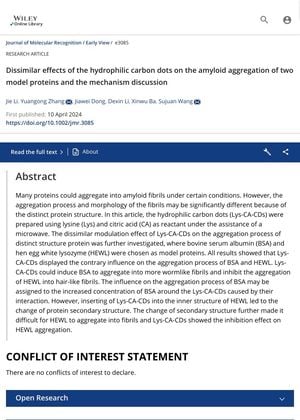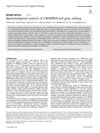Dissimilar Effects of Hydrophilic Carbon Dots on Amyloid Aggregation of Two Model Proteins and Mechanism Discussion
April 2024
in “
JMR. Journal of molecular recognition/Journal of molecular recognition
”

TLDR Hydrophilic carbon dots cause one protein to clump more and prevent another from clumping.
The research paper discusses the effects of hydrophilic carbon dots (Lys-CA-CDs), prepared using lysine and citric acid, on the aggregation process of two different proteins: bovine serum albumin (BSA) and hen egg white lysozyme (HEWL). The study found that Lys-CA-CDs had contrasting effects on these proteins. Specifically, Lys-CA-CDs induced BSA to aggregate into more wormlike fibrils, while they inhibited the aggregation of HEWL into hair-like fibrils. The increased concentration of BSA around the Lys-CA-CDs due to their interaction may be responsible for the influence on BSA's aggregation process. Conversely, the insertion of Lys-CA-CDs into the inner structure of HEWL altered the protein's secondary structure, making it more difficult for HEWL to aggregate into fibrils, thus demonstrating an inhibitory effect on HEWL aggregation.

